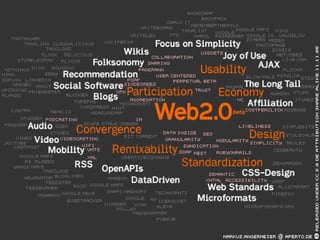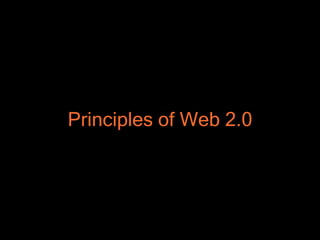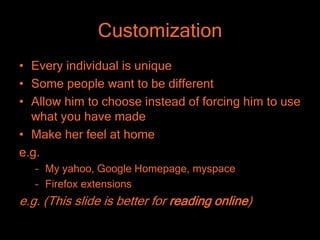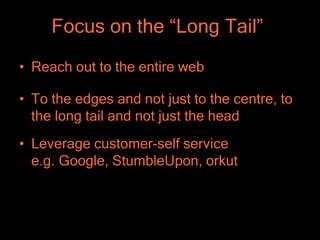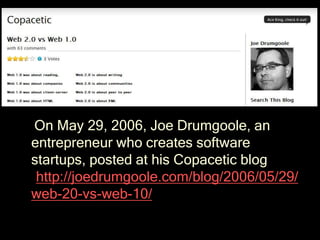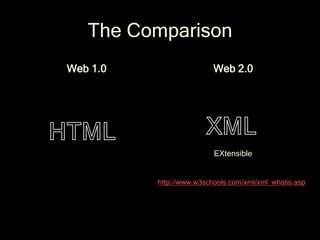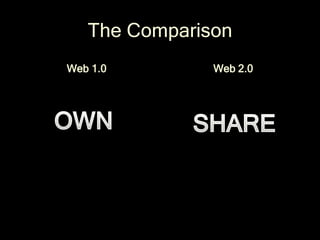Web 1 0 and 2-0
- 1. Have You Ever Thought of Being a Digital Disciple? Saturday, October 20, 2012– Diocesan Pastoral Center Sponsored by Office for Women Religious Diocese of San Diego WEB 2.0 AND SOCIAL MEDIA TOOLS – PART I
- 4. Web 1.0 was Commerce Web 2.0 is People - Ross Mayfield Web 2.0 seems to be like Pink Floyd lyrics: It can mean different things to different people, depending upon your state of mind. - Kevin Maney
- 5. Introduction • The concept of "Web 2.0" began with a conference brainstorming session between O'Reilly and MediaLive International in 2004 • The phrase "Web 2.0" hints at an improved form of the World Wide Web • Emphasizing tools and platforms that enable the user to Tag, Blog, Comment, Modify, Augment, Rank, etc. • The more explicit synonym of "Participatory Web"
- 6. Principles of Web 2.0
- 7. No Products but Services “There are no products, only solutions” • Not what customer wants but why they want • A problem solving approach • Simple Solutions
- 8. Customization • Every individual is unique • Some people want to be different • Allow him to choose instead of forcing him to use what you have made • Make her feel at home e.g. – My yahoo, Google Homepage, myspace – Firefox extensions e.g. (This slide is better for reading online)
- 9. Focus on the “Long Tail” • Reach out to the entire web • To the edges and not just to the centre, to the long tail and not just the head • Leverage customer-self service e.g. Google, StumbleUpon, orkut
- 10. Harnessing Collective Intelligence Network effects from user contribution are the key to market dominance in Web 2.0 era The Wisdom of crowds – Users add value – Amazon, ebay - User reviews, similar items, most popular, – Wikipedia – content can be added/edited by any web user, – Flickr – tagging images – Cloudmark – Spam emails
- 11. Harnessing Collective Intelligence.. Some systems,designed to encourage participation – Pay for people to do it – ‘gimme five’ – Get volunteers to perform the same task • Inspired by the open source community – Mutual benefits e.g. P2P sharing
- 12. Harnessing Collective Intelligence • But only a small percentage of users will go to the trouble of adding value to your applications via explicit means. • Therefore web 2.0 companies set inclusive defaults for aggregating user data and building value as side effect of ordinary use of the application. • It requires radical experiment in trust “with enough eyeballs, all bugs are shallow” - Eric Raymond
- 13. Benefits of Web 2.0 Recruitment: Due to the cutting-edge underlying technologies and usability-focused interfaces (the ‘cool’ factor) Organizations adopting Web 2.0 tend to attract sophisticated, high-caliber technical candidates. Reduced cost: Not only are Web 2.0 offerings low-cost, but the same techniques can also be applied to existing (non-Web 2.0) products and services, lowering costs. For example, wikis can enable your users to build documentation and knowledge base systems, with relatively little investment from yourself.
- 14. Benefits of Web 2.0 Loyalty The open, participatory Web 2.0 environment encourages user contribution, enhancing participant loyalty and lifespan. Marketing/PR. By taking advantage of the aforementioned benefits, marketing and PR teams can implement low-cost, wide- coverage, viral strategies. Search Engine Optimization (SEO) Web 2.0 delivery mechanisms - such as Blogs and RSS - significantly enhance search engine exposure through their distributed nature
- 15. On May 29, 2006, Joe Drumgoole, an entrepreneur who creates software startups, posted at his Copacetic blog (http://joedrumgoole.com/blog/2006/05/29/ web-20-vs-web-10/ )
- 16. The Comparison Web 1.0 Web 2.0
- 17. The Comparison Web 1.0 Web 2.0 Companies Communities
- 18. The Comparison Web 1.0 Web 2.0 EXtensible http://www.w3schools.com/xml/xml_whatis.asp
- 19. The Comparison Web 1.0 Web 2.0
- 20. The Comparison Web 1.0 Web 2.0
- 21. The Comparison Web 1.0 Web 2.0
- 22. The Comparison Web 1.0 Web 2.0 http://www.merriam-webster.com/dictionary/taxonomy http://techessence.info/tagging
- 24. We are dealing Today CULTURE LANGUAGE SKILLS CULTURE LANGUAGE SKILLS CULTURE LANGUAGE
- 25. QUESTION What does your Digital Footprint look like?
- 26. MindShift One goal is to help expand our understanding of communications technology by exploring ideas outside of the dominant worldview and assist you in waking up from what can be called “The Trance State," an unconscious but profound detachment from inner and outer reality. http://129.69.215.166/cgi-bin/blind/ger/research/fields/recent/brainshift/
- 27. Brain Freeze Brain freeze is your brain with all of the new technology … kind of like what happens when you eat ice cream too fast. It is delicious, but causes a brief headache. Peace, love and blessings in cyberspace, - Pam Emery
- 28. Summing Up • Participatory Culture • Users add value • Specialized Database • Perpetual Beta • Networking a value • Marketing and PR are changing • Communication is changing
- 29. Questions?
- 30. Resources Satyajeet Singh Web 2.0 Presentation (satyajeet.singh@yahoo.com)


